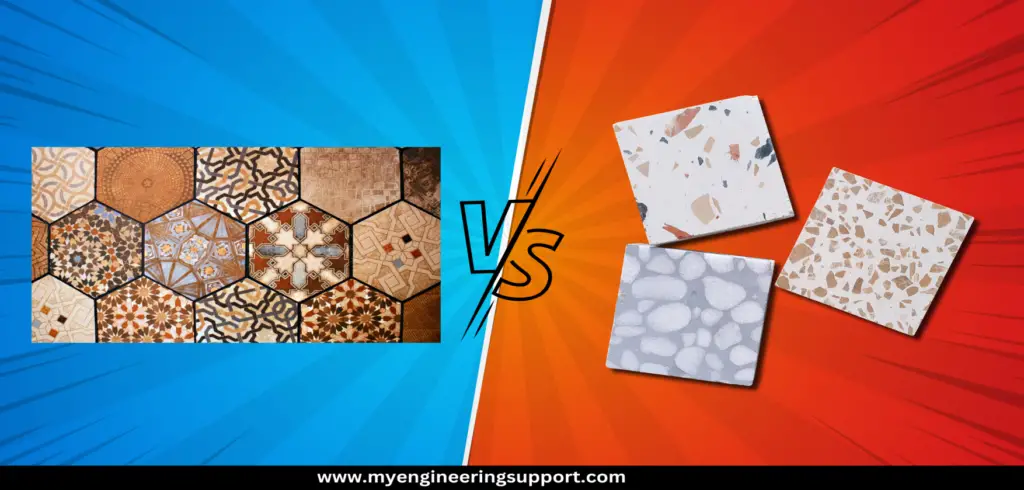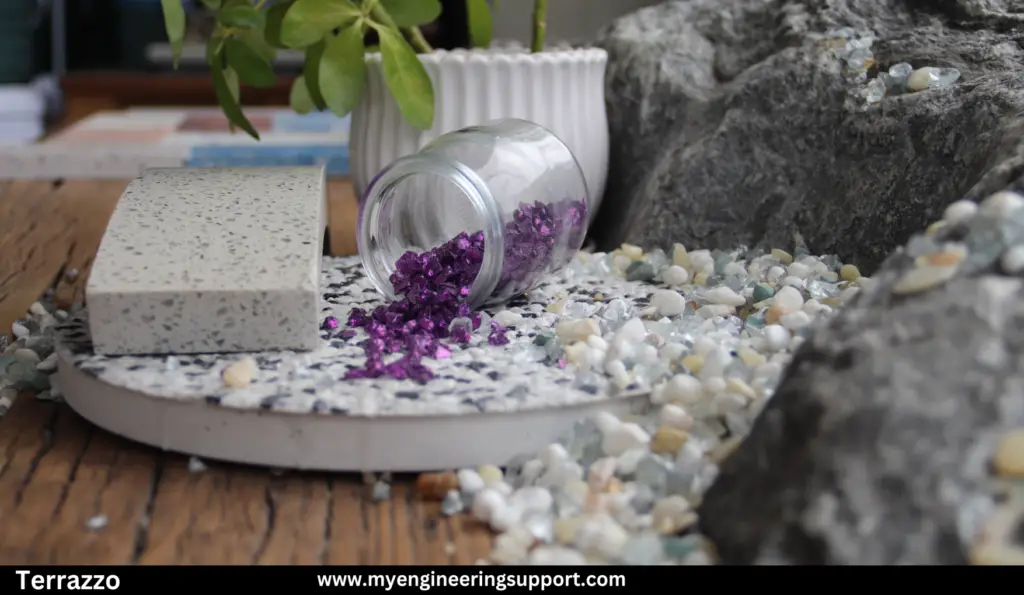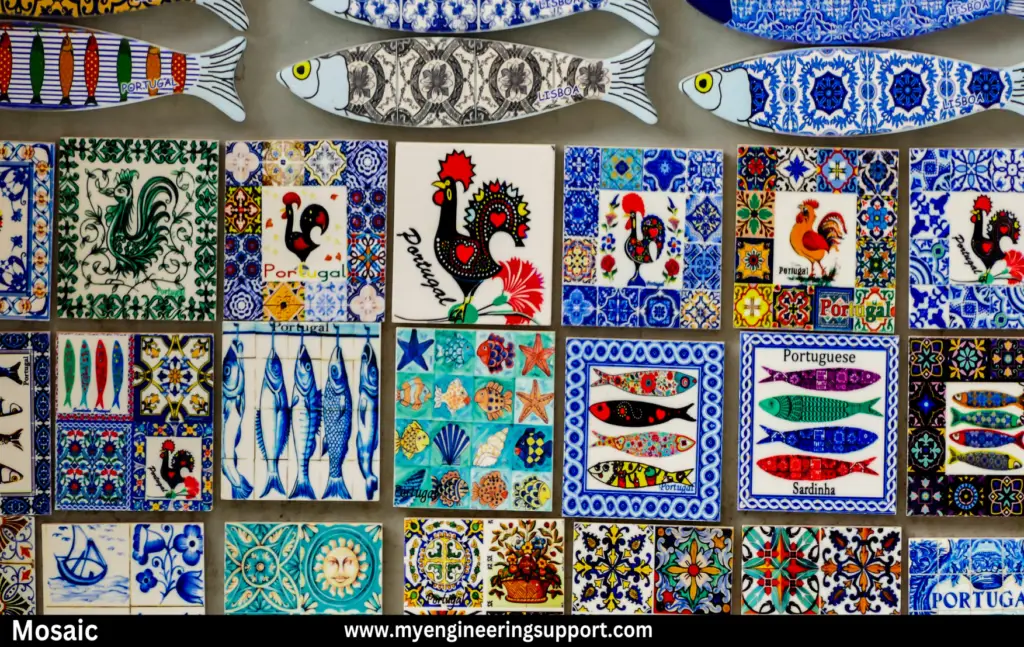Differences between Mosaic And Terrazzo Floorings
Introduction
Mosaic And Terrazzo Floorings are two distinctive flooring options that have been used for centuries to create visually stunning and durable surfaces. Mosaic flooring involves arranging small pieces of glass, ceramic, or stone called tesserae to form intricate patterns, while terrazzo combines various aggregates with a binding agent to create a polished surface.
Although they share some similarities, such as their ability to be customized and their longevity, there are notable differences in their composition, design options, installation process, maintenance requirements, and cost. Understanding these factors can help in choosing the most suitable flooring option for a specific project or space.

Composition
Mosaic Flooring Composition
Mosaic flooring is an ancient art form that involves arranging small pieces of glass, ceramic, or natural stone called tesserae to create intricate patterns or designs. The tesserae used in mosaic flooring can vary in shape, size, color, and material, allowing for endless design possibilities.
Tesserae Materials
Glass – Glass tesserae are available in various colors, finishes, and textures. They can be transparent, opaque, or iridescent, creating a captivating visual effect when exposed to light.
Ceramic – Ceramic tesserae are made from fired clay and can be glazed or unglazed. They offer a wide range of colors, patterns, and textures, allowing for intricate mosaic designs.
Natural Stone – Natural stone tesserae, such as marble, granite, limestone, or travertine, add a touch of elegance and durability to mosaic flooring. They come in different hues and can be polished or honed for a smooth or textured finish.

Adhesive and Grout
Adhesive – The tesserae in mosaic flooring are typically set in place using an adhesive or mortar. The adhesive binds the tesserae to the substrate, ensuring their stability and preventing movement over time.
Grout – Grout is used to fill the gaps between the tesserae, providing structural support and creating a seamless appearance. Grout can be colored to match or contrast with the tesserae, enhancing the overall design.
Terrazzo Flooring Composition
Terrazzo flooring is a composite material that combines various aggregates with a binding agent, resulting in a polished and durable surface. The composition of terrazzo flooring can vary depending on the desired aesthetics, performance requirements, and installation method.

Aggregates
Marble – Marble chips are a commonly used aggregate in terrazzo flooring. They come in various sizes and colors, offering a classic and luxurious appearance.
Granite – Granite chips provide a durable and resistant surface in terrazzo flooring. They are available in a range of colors and can create a speckled or textured effect.
Quartz – Quartz chips add durability and a wide array of colors to terrazzo flooring. They can be combined with other aggregates to achieve specific design effects.
Other Materials – Additional aggregates, such as mother-of-pearl, glass, or recycled materials, can be incorporated to create unique visual effects and sustainable flooring options.
Binding Agents
Cement – Cement is commonly used as the binding agent in traditional terrazzo flooring. It provides strength and stability to the composite material.

Epoxy Resin – Epoxy resin is another binding agent used in terrazzo flooring. It offers enhanced durability, chemical resistance, and a wider range of design possibilities due to its ability to be pigmented.
Installation Process
The installation processes for mosaic flooring and terrazzo flooring differ significantly due to their distinct compositions and construction methods. Here’s an overview of the installation processes for each type
Mosaic Flooring Installation
Subfloor Preparation – The subfloor needs to be clean, level, and structurally sound before installing mosaic flooring. It should be free of any debris or protrusions that may affect the installation.
Design and Layout – The design and layout of the mosaic pattern are planned and marked on the subfloor. This involves determining the placement of tesserae and creating a detailed layout plan.
Adhesive Application – A suitable adhesive or mortar is applied to the subfloor in small sections using a notched trowel. The adhesive should be compatible with the tesserae material and provide a strong bond.
Tesserae Placement – The tesserae, whether they are glass, ceramic, or natural stone, are carefully placed onto the adhesive following the predetermined design. They are pressed firmly into the adhesive to ensure a secure bond.

Grouting – Once the adhesive has cured and the tesserae are firmly in place, grout is applied to fill the gaps between the tesserae. Excess grout is wiped off the surface, and the grout lines are cleaned to achieve a uniform appearance.
Sealing – Depending on the material used for the tesserae and the desired level of protection, a sealant may be applied to the mosaic flooring to enhance its durability and prevent staining.
Terrazzo Flooring Installation
Subfloor Preparation – Similar to mosaic flooring, the subfloor should be properly prepared by ensuring it is clean, level, and structurally sound. Any cracks or imperfections in the subfloor are addressed before installation.
Formwork and Divider Strips – Formwork is set up along the edges of the installation area to contain the poured terrazzo mix. Divider strips are placed to create distinct sections within the flooring, allowing for expansion and contraction.
Terrazzo Mix Preparation – The terrazzo mix is prepared by combining aggregates (marble, granite, quartz, etc.) with a binder, such as cement or epoxy resin. The mixture should be properly proportioned to achieve the desired strength and consistency.

Pouring and Spreading – The prepared terrazzo mix is poured onto the subfloor between the formwork and divider strips. It is spread evenly using screeds or other tools to ensure a uniform thickness.
Grinding and Polishing – Once the terrazzo mix has cured and hardened, the surface is ground using diamond grinding tools to remove any imperfections and achieve a smooth finish. This process may involve multiple grinding and polishing stages to enhance the appearance and luster of the terrazzo.
Sealing – To protect the terrazzo surface and enhance its longevity, a sealant is applied. The type of sealant used can vary depending on the specific terrazzo composition and the desired level of protection.

It’s important to note that both mosaic flooring and terrazzo flooring installation processes require skilled professionals experienced in their respective techniques. The complexity and duration of the installation will depend on factors such as the size of the area, design intricacy, and the expertise of the installers.

Durability
Mosaic flooring is generally durable and can withstand regular foot traffic. The individual tesserae used in mosaic flooring, whether glass, ceramic, or natural stone, are typically resistant to wear and tear. However, the grout lines between the tesserae can be more susceptible to staining and may require periodic maintenance to retain their appearance and structural integrity.
Terrazzo flooring is highly durable and can withstand heavy foot traffic and use. The combination of aggregates (such as marble, granite, or quartz) and the binding agent (cement or epoxy resin) creates a robust and resilient surface. Terrazzo is resistant to scratches, stains, and impact damage, making it suitable for high-traffic areas.
Maintenance
Mosaic Flooring – Proper maintenance of mosaic flooring involves regular cleaning to prevent dirt and debris from accumulating on the surface. The grout lines between the tesserae should be periodically cleaned and sealed to prevent staining and discoloration. It is important to use gentle cleaning agents and avoid abrasive tools or harsh chemicals that could damage the tesserae or the grout.
Terrazzo Flooring – Terrazzo flooring maintenance typically involves regular sweeping or vacuuming to remove loose dirt and debris. Periodic mopping with a neutral pH cleaner helps to keep the surface clean and maintains its shine. Depending on the type of sealant used, occasional resealing may be necessary to protect the surface and enhance its longevity.
It’s worth noting that while both mosaic flooring and terrazzo flooring are durable, the long-term performance and maintenance requirements can vary based on factors such as the quality of materials, installation craftsmanship, and the level of care provided.

Appearance
Both mosaic flooring and terrazzo flooring offer visually stunning options, but their appearances differ in terms of scale, intricacy, texture, and overall style. The choice between the two depends on personal preferences, the desired ambiance, and the specific design objectives of the space.
Mosaic flooring and terrazzo flooring offer distinct appearances that can greatly enhance the aesthetics of a space. Here’s a comparison of their appearances:
Mosaic Flooring Appearances
Intricate Patterns – Mosaic flooring is known for its ability to create intricate patterns, images, and designs. The arrangement of small tesserae allows for limitless creative possibilities. Mosaics can feature vibrant colors, intricate details, and captivating visual effects.
Small-Scale Details – Due to the small size of the tesserae, mosaic flooring can showcase fine details and delicate artwork. It is often used to depict scenes, symbols, or intricate geometric patterns.
Textural Variety – Mosaic flooring offers a range of textures based on the materials used for the tesserae. Glass tesserae can provide a smooth and glossy surface, while natural stone tesserae can add depth and texture.
Artistic and Artisanal Feel – Mosaic flooring is often associated with artistry and craftsmanship. The intricate design and manual placement of tesserae conveys a sense of meticulous workmanship and attention to detail.
Terrazzo Flooring Appearances
Seamless and Uniform – Terrazzo flooring is characterized by its smooth and seamless appearance. The grinding and polishing process creates a continuous surface without visible joints or grout lines.
Aggregates and Color Variations – Terrazzo flooring showcases the beauty of various aggregates, such as marble, granite, or quartz. These aggregates can come in different colors, sizes, and shapes, offering a wide range of design possibilities.

Multicolored and Speckled Effect – The combination of different aggregates in terrazzo creates a multicolored and speckled effect throughout the floor. This effect can range from subtle and understated to bold and vibrant, depending on the chosen aggregates.
Reflective and Glossy Finish – Terrazzo is typically polished to a high gloss, resulting in a reflective surface that adds brightness and elegance to a space. The level of polishing can be adjusted to achieve different levels of shine.
Contemporary and Versatile – Terrazzo flooring has gained popularity for its modern and versatile aesthetic. It can be used in various settings, from residential to commercial, and complements a wide range of interior design styles.
Design Options
Mosaic flooring offers virtually unlimited design possibilities. The small tesserae can be arranged to create intricate patterns, images, or even murals. Various colors, shapes, and materials can be used to achieve unique and personalized designs.

Terrazzo also offers a wide range of design options. The aggregates used in terrazzo can vary in size, color, and type, allowing for different patterns and effects. It can be customized to match specific color schemes and design requirements.

Cost
The cost of mosaic flooring and terrazzo flooring can vary depending on several factors, including the materials used, the complexity of the design, the size of the area, and the local market conditions. Here’s a general comparison of the costs:
Mosaic Flooring Cost
Materials Cost – The cost of mosaic flooring materials can vary significantly based on the type of tesserae used (glass, ceramic, or natural stone), their quality, and the desired design. Higher-quality and more intricate designs often come at a higher price.
Installation Cost – Mosaic flooring installation requires skilled craftsmanship and meticulous attention to detail. The labor cost for mosaic flooring is generally higher compared to other types of flooring due to the time and expertise involved in placing and grouting the small tesserae.
Mosaic flooring tends to be on the higher end of the price spectrum for flooring options. The total cost can range from moderate to high, depending on the factors mentioned above.
Terrazzo Flooring Cost
Aggregates and Binder Cost – The cost of terrazzo flooring is primarily influenced by the type and quality of aggregates (marble, granite, quartz, etc.) used and the binding agent (cement or epoxy resin). Higher-quality or more exotic aggregates may increase the cost.
Installation – Terrazzo flooring installation involves pouring and finishing a mixture on-site, which can be less labor-intensive than the intricate placement of mosaic tesserae. This can contribute to lower labor costs compared to mosaic flooring.
Terrazzo flooring costs can vary from moderate to high, depending on the selected aggregates, binder, design complexity, and installation requirements. It generally falls within a similar price range as mosaic flooring but may have more cost-effective options depending on the chosen materials.

Here are the key differences between Mosaic And Terrazzo Floorings
|
Sl. No. |
Mosaic Flooring |
Terrazzo flooring |
|
1 |
Mosaic Flooring is made by arranging small pieces of colored glass, ceramic, or natural stone called tesserae in a pattern and grouting them. |
Terrazzo Flooring consists of a mixture of aggregates (such as marble, granite, and quartz) combined with a binding agent (cement or epoxy resin) that is poured, ground, and polished. |
|
2 |
It offers limitless design possibilities with intricate patterns, images, and artistic details. |
It provides a range of design options with multicolored aggregates and the ability to create a seamless and uniform appearance. |
|
3 |
Mosaic Flooring requires skilled craftsmanship to individually place and align tesserae, which can be time-consuming. |
Terrazzo Flooring involves pouring the terrazzo mixture, leveling it, and grinding it to achieve a smooth finish. Installation is typically faster compared to mosaic flooring. |
|
4 |
Showcases small-scale details, varied textures based on tesserae materials, and an artisanal feel. |
Offers a seamless surface without visible joints, featuring multicolored and speckled effects created by different aggregates. |
|
5 |
Mosaic Flooring is durable, but grout lines may require periodic maintenance to prevent staining or discoloration. |
Terrazzo Flooring is highly durable, resistant to wear and stains, and requires proper cleaning and periodic sealing to maintain its appearance. |
|
6 |
It is generally more expensive due to the intricate craftsmanship involved. |
It is generally less expensive than mosaic flooring but more costly than some other flooring options like ceramic tiles. |
Conclusion
Mosaic And Terrazzo Floorings are both popular choices for durable and visually appealing surfaces.
Mosaic flooring utilizes small, colored tiles to create intricate patterns or images. It offers a wide range of design possibilities and can be customized to suit various aesthetics. Mosaic floors are typically made from materials like ceramic, glass, or natural stone. While they require skilled craftsmanship and are more time-consuming to install, they create a stunning and unique look.
Terrazzo flooring consists of a mixture of marble, quartz, granite, or glass chips embedded in a binder, such as cement or epoxy resin. The mixture is poured and then polished to create a smooth, seamless surface. Terrazzo floors are known for their durability, versatility, and low maintenance requirements. They offer a wide range of color options and can be customized with different aggregate sizes and patterns.
In conclusion, both mosaic flooring and terrazzo flooring have their own unique characteristics and advantages. Mosaic flooring provides intricate designs and is ideal for creating artistic, detailed surfaces. Terrazzo flooring offers durability, versatility, and a wide range of design options. The choice between the Mosaic And Terrazzo Floorings ultimately depends on personal preferences, desired aesthetics, and specific project requirements.
Bar Bending Schedule (BBS) Basics Part -1

This Ebook is specially designed for Freshers Civil Engineers. Recommended for Quantity Surveyors & Billing Engineers. Here You Can Learn All Basic Concepts & Formulas for Bar Bending schedules (BBS).
I hope this information can be useful for you guys.
If you like this article then please share it with your friends & also like our Facebook Page and join our Telegram Channel.
If you want a PDF copy of this, Do let’s know by commenting & you can message us on our Instagram & telegram channel, or you can download it from the top right-hand corner of this post.

Thanks For the Great Attention!
Good Bye & Take Care
Happy Learning
Also, Read,
All About AAC Block – An Ultimate Guide
MDF VS Particle Board – 15 Important Differences
Flush Door vs Wooden Panel Door
Related Video



